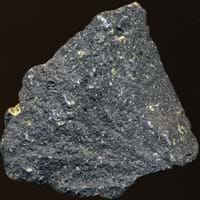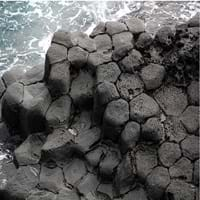Basalt is a common extrusive igneous rock formed by the rapid cooling of basaltic lava exposed at or very near the surface of Earth 0
From Late Latin Basaltes (variant of basanites ), very hard stone, which was imported from Ancient Greek Basanites 0
Durable Rock, Medium Hardness Rock 0
Fine Grained Rock, Opaque Rock 0
Glassy, Massive, Porphyritic, Scoriaceous, Vesicular 0
Black, Brown, Light to Dark Grey 0
Floor Tiles, Homes, Hotels, Kitchens 0
As Building Stone, Paving Stone, Garden Decoration, Office Buildings 0
Arrowheads, As Dimension Stone, Cobblestones, Cutting Tool, Rail Track Ballast, Roadstone 0
An Oil and Gas Reservoir, Commemorative Tablets, Creating Artwork, Used in aquariums 0
Alkaline Basalt, Boninite, High Alumina Basalt, Mid Ocean Ridge Basalt (MORB), Tholeiitic Basalt, Basaltic trachyandesite, Mugearite and Shoshonite 0
Has High structural resistance against erosion and climate, Very fine grained rock 0
Archaeological Significance
0
Easter Island in the Polynesian Triangle, Pacific Ocean, Gateway of India in Mumbai, India, Gol Gumbaz in Karnataka, India 0
Basalt forms when lava reaches the Earth's surface near an active volcano. The temperature of lava is between 1100 to 1250° C when it gets to the surface. 0
Olivine, Plagioclase, Pyroxene 0
Aluminium Oxide, CaO, Iron(III) Oxide, FeO, Potassium Oxide, MgO, MnO, Sodium Oxide, Phosphorus Pentoxide, Silicon Dioxide, Titanium Dioxide 0
Heat Resistant, Pressure Resistant, Wear Resistant 0
Deposits in Eastern Continents
0
Deposits in Western Continents
0
Deposits in Oceania Continent
0
Learn more about Properties of Basalt
What is Basalt? In this section, we will learn more about properties of Basalt i.e. physical and thermal properties. Physical properties of Basalt include Color, Streak, Hardness, Structure, Cleavage, Fracture, Luster, Specific Gravity etc. The strength of Basalt is 37.40 N/mm2. Streak of Basalt is white to grey while its cleavage is not available. Luster of Basalt is not available and its fracture is conchoidal. Basalt is opaque in nature. Know all about Basalt, What is Basalt, its composition, features, facts and reserves in next sections.
Know about Composition of Basalt
What is Basalt composed of? Get to know about composition of Basalt here. Basalt definition gives information about the Formation of Basalt and its composition.The composition of Basalt can be further divided into mineral and compound content. The mineral content of Basalt rock includes Olivine, Plagioclase, Pyroxene and The compound content of Basalt rock includes Aluminium Oxide, CaO, Iron(III) Oxide, FeO, Potassium Oxide, MgO, MnO, Sodium Oxide, Phosphorus Pentoxide, Silicon Dioxide, Titanium Dioxide. Almost all rocks undergo transformation process. Know all about Basalt rock in next section.











